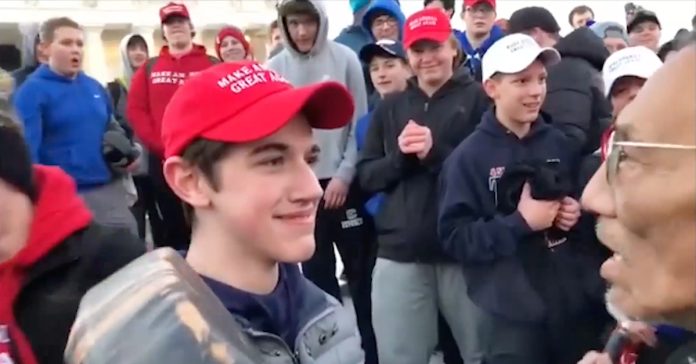
Nick Sandmann, who at the time was a Covington Catholic student, appears in a screengrab taken from a video filed as an exhibit in federal court.
In an orders list on Monday, the U.S. Supreme Court refused to take up Nick Sandmann’s case against the New York Times, CBS, ABC, Rolling Stone, and Gannett, bringing an end to his libel lawsuits against the media for its coverage of his encounter with Native American activist Nathan Phillips at the March for Life in Washington, D.C., back in 2019.
After Sandmann filed his petition for a writ of certiorari in January, the media organizations the next month each waived the right to respond.
In the petition, Sandmann’s lawyers maintained that the U.S. Court of Appeals for the Sixth Circuit was wrong to conclude media who reported Phillips’ account that Sandmann had “blocked [his] way and wouldn’t allow me to retreat” had published statements that were “protected opinions.”
Referring to Sandmann as an “innocent high school student” at the time of the incident and a subsequent victim of “cancel culture,” the attorneys argued that statements about Sandmann’s movements that day were “loaded with defamatory implications,” as saying that a “white teenager from a private Catholic school wearing a red MAGA hat was physically blocking the progress of a peaceful Native American protestor carried unmistakable connotations of racism, intolerance, intimidation, and insensitivity.”
Sandmann’s life was never the same from that point on, and all over an “embarrassed smile,” the petition continued.
“The consequences for Sandmann were immediate and catastrophic. Over the ensuing hours, as he slept on the bus back to Kentucky, and over the next day, Nicholas Sandmann changed from a quiet, anonymous teenager into a national social pariah, one whose embarrassed smile in response to Phillips’ aggression became a target for anger and hatred, the subject of media commentary and talk-show invective, his name and reputation forever tarnished,” the petition said. “Sandmann was denounced by his church diocese, denied re-admission to his high school, and attacked in the national media. Round-the-clock police protection was assigned to his house; his visage was featured on nearly all major television outlets, with celebrity commentators stating that they would “like to punch him in the face,’ and worse.”
Last August, the Sixth Circuit in a 2-1 decision found that the “blocking” statements at issue were “nonactionable” opinion because, as the lower court also found, the media had published Phillips expressing “his subjective understanding of the situation and of Sandmann’s intent, an understanding informed by the pair’s proximity, the other students’ movement, and the lack of communication during the encounter.”
“Phillips’s statements are opinion, not fact,” the panel majority would add.
After Sixth Circuit last October declined to rehear the case en banc, Sandmann in January told the high court that Phillips’ “sensory impressions” were reported by the media in “factual, descriptive terms,” making those false and libelous statements of fact:
1. Do statements conveying observed sensory impressions in factual, descriptive terms constitute protected “opinion” under the First Amendment to the Constitution of the United States?
2. Did the United States Court of Appeals for the Sixth Circuit effectively eliminate the distinction between fact and opinion articulated in Milkovich v. Lorain Journal Company, 497 U.S. 1 (1990)?
Now, just two months after the petition was filed, the justices declined to hear the case and did not write separately on the denial.
Have a tip we should know? [email protected]

